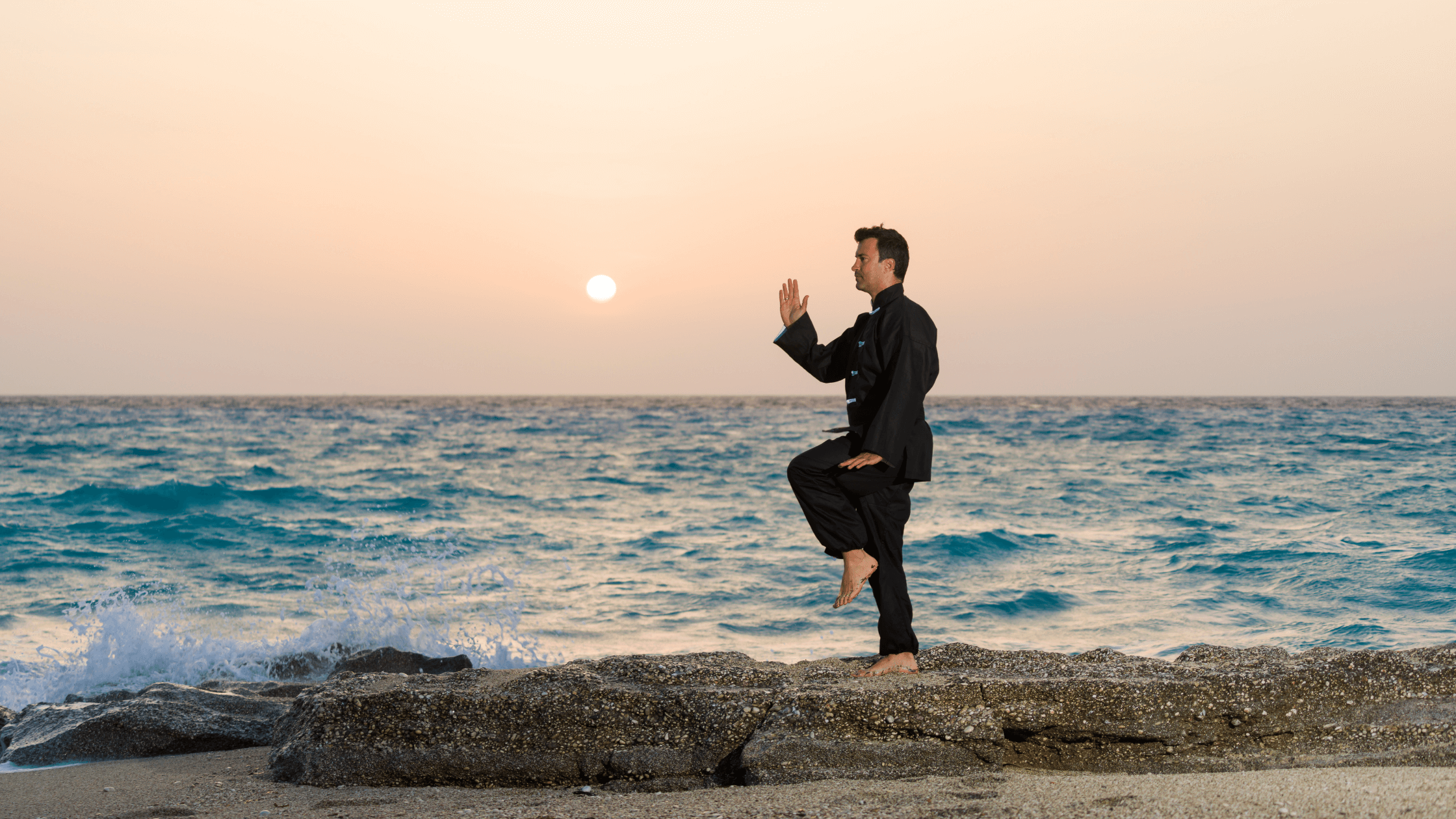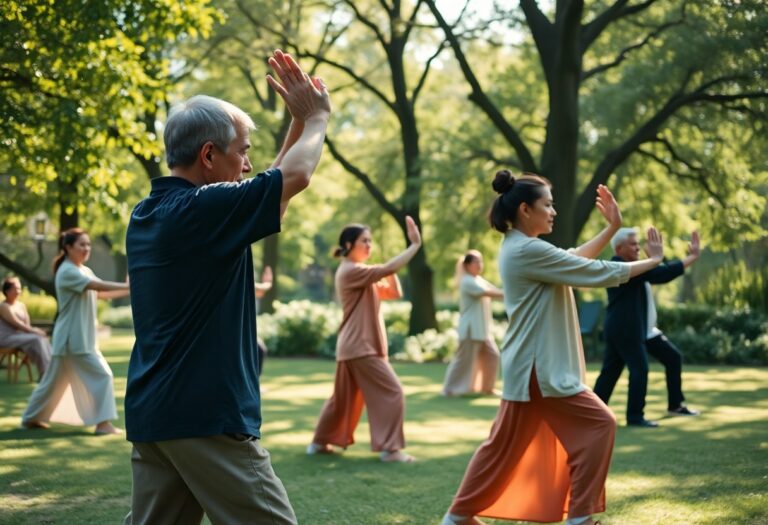Tai Chi helps reduce fall risk in older adults through several key mechanisms: Physical Benefits
Most older adults face the risk of falls, which can lead to serious injuries and diminished quality of life. Engaging in Tai Chi offers numerous physical benefits that can significantly enhance your balance, muscle strength, and coordination, thereby reducing this risk.
By incorporating mindful movement and focused practice into your routine, you can improve your postural stability, strengthen vital muscles, and develop a greater awareness of your body, all of which contribute to a safer and more secure way of navigating your environment.
Physical Mechanisms of Tai Chi
While engaging in Tai Chi, you experience a unique blend of movements that significantly enhance your physical capabilities. The practice focuses on deliberate and controlled motions, allowing you to develop strength, balance, and coordination, all of which are vital for reducing your risk of falls as you age.
Balance and Postural Control
For older adults, maintaining balance and postural control is vital in preventing falls. Tai Chi promotes increased postural stability by strengthening your core muscles and enhancing your body awareness, enabling you to respond effectively to shifts in weight and movement.

Muscular Strength Development
Across various Tai Chi forms, you build muscular strength, particularly in your legs and hips. The slow, flowing movements target key muscle groups, improving overall stability and reducing vulnerability to falls.
Physical strength gained through Tai Chi not only builds leg strength but also enhances ankle flexibility, which is vital for maintaining balance. As you progress, you’ll notice that these gains contribute to better control over your movements, leading to improved walking stability and increased confidence when navigating different environments.
Movement Coordination Enhancement
Behind the fluid movements of Tai Chi lies a profound enhancement of your coordination skills. This practice encourages a strong mind-body connection, enabling you to perform transitions more smoothly and with greater control.
In fact, effective coordination plays a significant role in maintaining your mobility. As you cultivate this skill through Tai Chi, you will find that movement control becomes second nature, allowing you to react swiftly to unexpected situations and maintain a confident gait, ultimately reducing your overall fall risk.
Neurological Adaptations
Now, engaging in Tai Chi not only provides physical benefits but also stimulates beneficial neurological adaptations that contribute to reduced fall risk. As you practice, your brain develops new pathways and enhances coordination, which can lead to improved balance and sensory awareness. This deepening of mind-body connections paves the way for greater movement control and reaction times, crucial for maintaining stability as you age.
Sensory Integration
At the core of Tai Chi’s effectiveness is its emphasis on sensory integration. Through mindful movement and focused attention, you sharpen your ability to process sensory information from your surroundings. This enhancement allows you to better respond to shifts in your environment, ultimately leading to a decreased risk of falls.
Motor Response Patterns
Against the backdrop of these sensory improvements, Tai Chi fosters refined motor response patterns. As you practise varied movements, your body learns to react more fluidly and efficiently to changes in balance and stability, reducing the likelihood of missteps and falls during everyday activities.
A key aspect of improving your motor response patterns lies in the gradual progression of Tai Chi movements. The slow, intentional practice not only helps strengthen your muscle memory but also creates a smooth transition between postures. This increasingly automatic response to unexpected challenges is integral in maintaining your balance during daily life, allowing for more confident interactions with your environment.
Cognitive-Motor Connection
For effective fall prevention, you must also consider the cognitive-motor connection that Tai Chi nurtures. As you engage in the practice, your cognitive functions—such as focus and spatial awareness—are sharpened, which supports quicker and more coordinated physical responses.
In addition, this cognitive-motor connection enhances your overall mindfulness during physical activities. By becoming more aware of your body in space, you can better anticipate potential hazards. This heightened awareness translates to improved movement choices and decision-making, fostering a safer environment for you and significantly reducing the risk of falls over time.
Practical Implementation
Once again, the effective implementation of Tai Chi in your daily routine can significantly enhance the physical benefits associated with this practice. To reap the rewards, aim to incorporate regular training sessions into your week, progressively increasing the duration and complexity of your exercises. Ensure you engage in a safe environment, free from distractions, and focus on proper form to maximise stability and balance. Seeking professional instruction can further enrich your experience and help you stay motivated.
Training Methodology
Practical training in Tai Chi involves structured sessions that emphasise consistency and gradual skill development. You can choose to attend qualified classes or follow guided sessions online that cater to your ability level. The focus should be on mastering foundational movements before progressing to more complex forms, thereby building your confidence and ensuring safety throughout your practice.
Progressive Learning Stages
About progressing through different learning stages in Tai Chi enables you to build your skills systematically. Each stage is designed to enhance your strength, balance, and coordination incrementally, allowing you to adapt to the practice at your own pace. This tailored approach not only fosters physical improvements but also encourages a deeper understanding of your body’s capabilities.
At each stage, you will encounter increasing challenges that aim to enhance your overall proficiency. Starting with basic postures and movements, you will gradually work towards more intricate sequences that require greater focus and fluidity. By regularly assessing your progress, you can adjust your goals as needed, ensuring that both your physical and mental capabilities are continually enhanced while minimising the risk of falls.
Safety and Adaptation
To ensure a safe practice environment, it’s important to consider individual capabilities and requirements. You should seek medical clearance from your healthcare provider, as they can help identify any physical limitations and advise on suitable adaptations to Tai Chi movements. This proactive approach enables you to participate confidently while minimising the risk of injury.
Individual Assessment
With a thorough assessment of your physical abilities, you can tailor your Tai Chi practice to suit your unique needs. Evaluating your balance, strength, and mobility will inform the appropriate modifications to be made. Regular progress checks are important, ensuring you maintain a safe and effective practice that evolves with your capabilities.
Environmental Considerations
About your practice environment, it is important to create a safe space that reduces the likelihood of falls. Ensuring proper lighting, non-slip surfaces, and an appropriate temperature will contribute significantly to your overall safety during Tai Chi sessions.
Plus, by maintaining a clear and unobstructed practice area, you can focus on your movements without distractions or hazards. Consider wearing appropriate footwear that provides sufficient support and grip. By being mindful of these environmental factors, you can enhance your Tai Chi experience while minimising risks, making it easier for you to focus on balance improvement and movement control. Regularly assess your surroundings to ensure a safe and conducive environment for your practice.
Physiological Impact
Despite the common perception that fall risk is an unavoidable consequence of ageing, engaging in Tai Chi can significantly influence your physiological health. The practice enhances your balance, strength, and coordination, which are all vital components in minimising fall risk. Studies have shown improvements in balance scores and a decrease in fall incidents among older adults who regularly practice Tai Chi. This holistic form of exercise thus contributes to your overall well-being and daily functionality.
Musculoskeletal Benefits
By participating in Tai Chi, you build not only leg strength but also enhance core stability, which plays a vital role in maintaining your postural control. Improved muscle strength and flexibility contribute to more stable movements, which can directly reduce your chances of falling.
Sensory System Enhancement
Besides the strength and flexibility benefits, Tai Chi also positively impacts your sensory systems, aiding in spatial awareness and reaction times. This comprehensive training helps you become more attuned to your body’s movements and the environment around you, further lowering the risk of falls.
This increased sensory awareness allows you to respond more effectively to environmental changes, such as uneven surfaces or obstacles. As you refine your proprioception through Tai Chi, you develop heightened spatial orientation, which improves your awareness of body positioning. Enhanced reflexes resulting from focused practice lead to quicker responses in maintaining balance during unexpected movements. Ultimately, these improvements offer you greater confidence, empowering you to engage in daily activities with reduced fear of falling.

Behavioural Modifications
Keep in mind that behavioural modifications play a significant role in reducing fall risk. Engaging in Tai Chi can lead you to develop healthier movement patterns and habits that enhance your stability. By practising regularly, you train your body to respond better to unexpected shifts, ultimately ensuring safer navigation through your environment.
Movement Confidence
Movement confidence grows as you progress in your Tai Chi practice. Each session builds your strength and balance, which instils a sense of security in your movements. As your ability to control your body improves, so does your willingness to engage in daily activities, reducing your fear of falling.
Risk Awareness
Below the surface of improved balance lies a heightened risk awareness that emerges through regular Tai Chi practice. You develop a better understanding of your personal limits and the potential hazards in your environment. This awareness is vital in making safer choices in everyday situations, ultimately contributing to your overall safety and well-being.
Modifications in your awareness of risk enable you to identify situations that may lead to falls, such as uneven surfaces or overly cluttered areas. By recognising these hazards, you can adjust your movements accordingly, ensuring a proactive approach to fall prevention. This increased vigilance not only promotes safer practices during activities but also empowers you to manage your environment more effectively, further enhancing your confidence and independence.
Conclusion
With this in mind, engaging in Tai Chi offers you numerous physical benefits that significantly aid in reducing the risk of falls as you age. By improving your balance, muscle strength, and coordination, you enhance your postural stability and body awareness. These benefits collectively contribute to a more confident and stable movement pattern in your daily activities, supporting your overall mobility and independence. Incorporating Tai Chi into your routine can thus be an effective strategy for promoting your long-term physical health.







